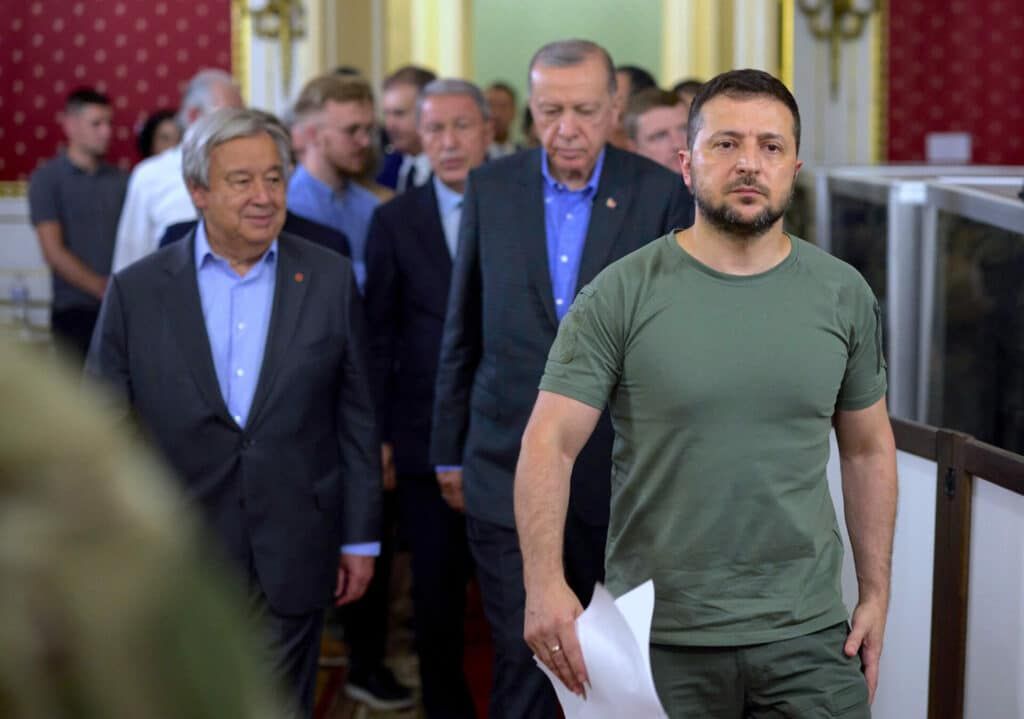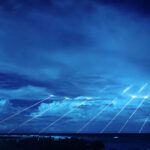Deteriorating situation at Ukraine’s largest nuclear power plant
By Dawn Stover | August 19, 2022
 Ukrainian President Volodymyr Zelensky (right) met with UN Secretary General António Guterres (left) and Turkish President Recep Tayyip Erdogan (center) in Lviv on August 18, 2022. Credit: Presidential Office of Ukraine
Ukrainian President Volodymyr Zelensky (right) met with UN Secretary General António Guterres (left) and Turkish President Recep Tayyip Erdogan (center) in Lviv on August 18, 2022. Credit: Presidential Office of Ukraine
Russian forces have occupied the Zaporizhzhia Nuclear Power Station in southern Ukraine for more than five months, placing the power plant’s six nuclear reactors and its stores of radioactive spent fuel at unprecedented risk. The situation at the plant continues to worsen.
Russia and Ukraine, which blamed each other for earlier attacks on the plant, are this week trading fresh accusations and warning that another attack on the plant is coming soon.
Ukrainian military intelligence told NBC News that Russia had ordered most of the Zaporizhzhia plant’s staff to stay home from work today. On its verified Facebook page, the Ukrainian intelligence directorate of the defense ministry claimed there is a “high likelihood” of a large-scale terrorist attack on the facility.
The Russian Ministry of Defense earlier accused the Ukrainian military of preparing to launch a terrorist attack on the Zaporizhzhia plant. The ministry acknowledged it is considering a shutdown of the plant in response to “negative developments.”
Energoatom, Ukraine’s state-owned nuclear utility, warned that shutting down the plant would make a radiation disaster scenario more likely. It would also cut off a significant source of electricity for Ukraine’s grid.
At a US State Department briefing yesterday, department spokesman Ned Price said statements from Russian officials are “cause for concern because they fit squarely within the Russian playbook: accuse others of what it is you have done or what it is you intend to do.” He said Russia “has engaged in a number of false flag operations” and that the United States would be watching the situation at the Zaporizhzhia power plant “very closely.”
International intervention. In the Western Ukraine city of Lviv yesterday, Ukrainian President Volodymyr Zelensky met with UN Secretary General António Guterres and Turkish President Recep Tayyip Erdogan. It was the first meeting between Zelensky and Guterres since the Russian invasion of Ukraine began in late February.
On his official Telegram account, Zelensky wrote that he and Guterres paid “particular attention” at their summit to Russia’s “nuclear blackmail” at the Zaporizhzhia plant. Zelensky called on the United Nations to “ensure the security” of Zaporizhzhia, which is the largest nuclear power plant in Europe.
Guterres said he is “gravely concerned” about potentially “suicidal” damage to the plant. However, it is unclear what the United Nations can do to help.
In response to a Russian accusation that the UN Secretariat has canceled or blocked a visit by the International Atomic Energy Agency (IAEA) to the plant, the Secretariat clarified that it has no authority to block any IAEA activities. (The IAEA, which has made repeated and increasingly urgent requests for a visit, reports to the United Nations, but it is an autonomous organization.)
The Secretariat said it would support any IAEA mission to Zaporizhzhia and has “in Ukraine” the logistics and security capacity to do so. Russia has said it will allow an IAEA visit to the plant, but the Russians want the mission to travel to the plant through Russian-occupied territory and have claimed it would be too dangerous for an international mission to approach from Kyiv. A Russian-controlled route is unacceptable to Ukrainian officials, who worry that it could be seen as a tacit acknowledgement by the IAEA that Russia now “owns” the plant.
The specter of Chernobyl (and Fukushima). After the summit in Lviv, Erdogan warned about the potential for “another Chernobyl.” An anonymous worker at the Zaporizhzhia plant used similar language on Tuesday, telling ABC News: “If something happens to the spent fuel storage, the consequences could be the same as Chernobyl.”
Mistakes made by plant operators during a test caused a reactor at the Chernobyl nuclear power plant to go out of control in 1986, resulting in an explosion and fire that released large amounts of radiation into the atmosphere. While the reactors at the Zaporizhzhia plant are a different type than the flawed design used at Chernobyl, the chances for operator error are rising as the occupation drags on. Ukrainian employees of the state-owned nuclear utility Energoatom continue to run the plant, but they are working in an extremely stressful environment, and are constantly under Russian observation and suspicion.
Operator error is only one of the risks facing the nuclear plant. Another possibility is more akin to the Fukushima nuclear reactor meltdowns than to Chernobyl: If the Zaporizhzhia plant were to face an extended loss of electrical power because of an accidental or intentional attack, the plant operators might not be able to continue pumping cool water into the reactor cores and spent-fuel storage pools to prevent radioactive fuel from overheating.
A militarized zone. An agreement between Ukraine and Russia on grain exports, mediated by Erdogan, raised hopes that a similar agreement could be negotiated to halt military activities in and around the Zaporizhzhia site. Guterres called for establishment of a demilitarized zone around the plant, but Russia rejected the idea, saying the Russians need to “protect” the plant from provocations and terrorist attacks.
Zaporizhzhia is not the only nuclear power plant caught in the crossfire between Russia and Ukraine. Earlier this week, Russia accused “Ukrainian saboteurs” of blowing up six towers supporting high-voltage power lines that transmit electricity from the Kursk Nuclear Power Plant in western Russia, near the border with Ukraine.
Fierce fighting continues in the vicinity of the Zaporizhzhia plant. In an address on Saturday, Zelensky said Ukraine would target Russian soldiers shooting at, or from, the plant. The plant is located on the south side of the Dnipro River, and Russia has been firing artillery shells and rockets at Ukrainian-controlled towns on the river’s north side.
On Thursday, CNN reported, the Russian defense ministry issued a statement insisting that “weapons, especially heavy ones, are not placed on the territory of this [nuclear] station” and said it was ready to present high-resolution satellite images to the IAEA as proof.
Together, we make the world safer.
The Bulletin elevates expert voices above the noise. But as an independent nonprofit organization, our operations depend on the support of readers like you. Help us continue to deliver quality journalism that holds leaders accountable. Your support of our work at any level is important. In return, we promise our coverage will be understandable, influential, vigilant, solution-oriented, and fair-minded. Together we can make a difference.
Keywords: Russia, Ukraine, Zaporizhzhia
Topics: Nuclear Energy, Nuclear Risk
















If there is a repeat of the 1986 Chernobyl event, what actions are required to cope with such an event? What geographic regions would the fallout areas include? Are doses of iodine pills available to citizens of countries such Sweden and the U.K.?